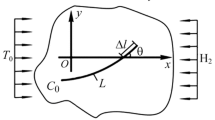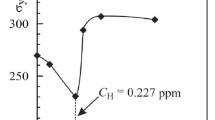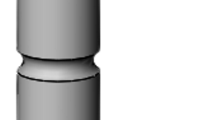We formulate a mathematical model for the determination of the effect of hydrogen on the period of initiation of creep-fatigue macrocrack in the vicinity of a stress concentrator in a plate. By using this model, we find the period of initiation of a macrocrack for a strip with two side notches under cyclic loads, high temperatures, and the action of hydrogen-containing medium. It is shown that hydrogen increases the rate of crack initiation in steel plates.




Similar content being viewed by others
References
O. E. Andreikiv, I. Ya Dolins’ka, and N. V. Yavors’ka, “Estimation of the periods of initiation and propagation of creep-fatigue cracks in thin-walled structural elements,” Fiz.-Khim. Mekh. Mater., 47, No. 3, 7–15 (2011); English translation: Mater. Sci., 47, No. 3, 273–283 (2011).
A. E. Andreikiv, Three-Dimensional Problems of the Theory of Cracks [in Russian], Naukova Dumka, Kiev (1982).
F. Garofalo, Fundamentals of Creep and Creep-Rupture in Metals, MacMillan, New York (1970).
D. N. Gladwin, D. A. Miller, G. J. Neate, and R. H. Priest, “Creep, fatigue and creep-fatigue crack growth rates in parent and simulated HAZ type 321 stainless steel,” Fatigue Fract. Eng. Mater. Struct., 11, No. 5, 35 (1988).
A. E. Andreikiv and A. I. Darchuk, Fatigue Fracture and Durability of Structures [in Russian], Naukova Dumka, Kiev (1992).
L. Babii, O. Student, and A. Zahors’kyi, “Properties of 15Kh2MFA hull plate under the conditions of creep in gaseous hydrogen,” Fiz.-Khim. Mekh. Mater., Vol. 1, Special issue No. 7, 100–105 (2008).
A. M. Lokoshchenko, A. A. Il’in, A. M. Mamonov, and V. V. Nazarov, “Analysis of the creep and long-term strength of VT6 titanium alloy with preliminarily injected hydrogen,” Fiz.-Khim. Mekh. Mater., 44, No. 5, 98–104 (2008); English translation: Mater. Sci., 44, No. 5, 700–707 (2008).
O. E. Andreikiv and O. V. Hembara, Fracture Mechanics and Durability of Metal Materials in Hydrogen-Containing Media [in Ukrainian], Naukova Dumka, Kyiv (2007).
V. V. Panasyuk, A. E. Andreikiv, and V. Z. Parton, Fundamentals of Fracture Mechanics [in Russian], Vol. 1, Naukova Dumka, Kiev (1988).
O. E. Andreikiv and N. B. Sas, “Subcritical growth of a plane crack in a three-dimensional body under the conditions of hightemperature creep,” Fiz.-Khim. Mekh. Mater., 44, No. 2, 19–26 (2008); English translation: Mater. Sci., 44, No. 2, 163–174 (2008).
S. Ya. Yarema and V. V. Popovich, “Influence of the structure and stress concentration on the period of initiation of fatigue cracks in 65G steel,” Fiz.-Khim. Mekh. Mater., 9, No. 6, 66–72 (1973).
Author information
Authors and Affiliations
Corresponding author
Additional information
Translated from Fizyko-Khimichna Mekhanika Materialiv, Vol. 50, No. 4, pp. 34–40, July–August, 2014.
Rights and permissions
About this article
Cite this article
Andreikiv, O.E., Dolins’ka, I.Y., Dobrovol’s’ka, L.N. et al. Influence of Hydrogen on the Initiation of Creep-Fatigue Cracks in Plates Near Stress Concentrators. Mater Sci 50, 507–515 (2015). https://doi.org/10.1007/s11003-015-9748-5
Received:
Published:
Issue Date:
DOI: https://doi.org/10.1007/s11003-015-9748-5




